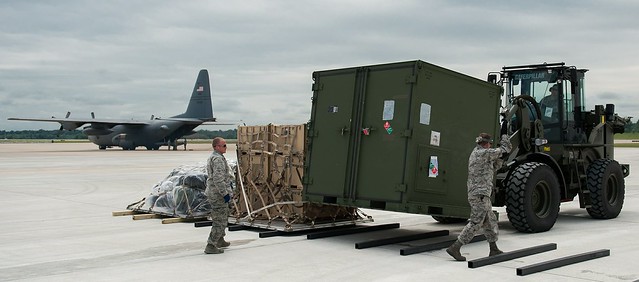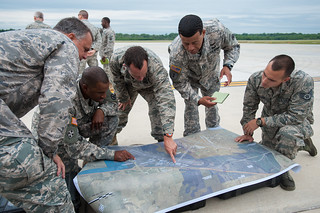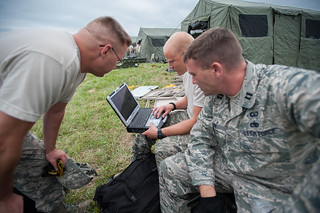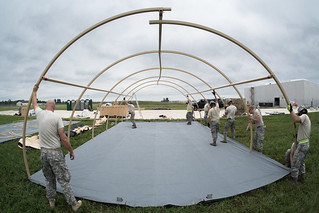Story by Maj. Dale Greer, 123rd Airlift Wing Public Affairs
[caption id="" align="aligncenter" width="576"]

Airmen from the Kentucky Air National Guard’s 123rd Contingency Response Group marshal equipment at MidAmerica St. Louis Airport in Mascoutah, Ill., on Aug. 5, 2013, as part of Exercise Gateway Relief, a U.S. Transportation Command-directed earthquake-response scenario. The 123rd is joining forces with the U.S. Army’s active-duty 689th Rapid Port Opening Element from Fort Eustis, Va., to stand up and operate a Joint Task Force-Port Opening, which combines an Air Force Aerial Port of Debarkation with an Army trucking and distribution unit. The aerial port ensures the smooth flow of cargo and relief supplies into affected areas by airlift, while the trucking unit facilitates their final distribution over land. (U.S. Air National Guard photo by Maj. Dale Greer/Released)
MASCOUTAH, Ill. — Nearly 100 members of the Kentucky Air National Guard’s 123rd Contingency Response Group and the U.S. Army’s 689th Rapid Port Opening Element deployed to MidAmerica St. Louis Airport on Monday to set up a logistics hub as part of Exercise Gateway Relief, an earthquake-response scenario directed by United States Transportation Command.
Click here to see more great photos on this story!
An additional 37 Kentucky Air Guardsmen arrived Tuesday, completing the mission’s full staffing at 135 personnel, said Col. Mark Heiniger, commander of the 123rd CRG.
[caption id="" align="alignleft" width="320"]

Airmen from the Kentucky Air National Guard’s 123rd Contingency Response Group and Soldiers from the U.S. Army’s active-duty 689th Rapid Port Opening Element from Fort Eustis, Va., examine a map to determine the placement of disaster-response facilities at MidAmerica St. Louis Airport in Mascoutah, Ill., on Aug. 5, 2013, as part of Exercise Gateway Relief, a U.S. Transportation Command-directed earthquake-response scenario. (U.S. Air National Guard photo by Maj. Dale Greer/Released)
The two units will work together through Friday to stand up and operate a Joint Task Force-Port Opening, or JTF-PO, which combines an Air Force Aerial Port of Debarkation with an Army trucking and distribution unit. The aerial port ensures the smooth flow of cargo and relief supplies into disaster areas via airlift, while the trucking unit facilitates final distribution over land.
“Our mission is to rapidly establish a Joint Task Force-Port Opening, with the 123rd CRG providing air mobility expertise and the 689th RPOE providing ground surface-movement expertise,” said Heiniger, who is also JTF-PO commander.
“We will operate as one team to expedite the movement of cargo from MidAmerica St. Louis Airport to a forward node for further distribution. The goal is the safe and expeditious movement of cargo and passengers with accurate in-transit visibility: getting the right stuff to the right place at the right time.”
[caption id="" align="alignright" width="320"]

Airmen from the Kentucky Air National Guard’s 123rd Contingency Response Group create an aircraft parking plan at MidAmerica St. Louis Airport in Mascoutah, Ill., on Aug. 5, 2013, as part of Exercise Gateway Relief, a U.S. Transportation Command-directed earthquake-response scenario. (U.S. Air National Guard photo by Maj. Dale Greer/Released)
This combined air-land capability, which exists in only one Unified Combatant Command, USTRANSCOM, is designed to provide key assistance during national or international emergencies, officials said. In the United States, for example, a JTF-PO can help civilian authorities respond to natural disasters like hurricanes or earthquakes.
This week’s exercise is based on a scenario in which two major earthquakes have struck the New Madrid Seismic Zone, resulting in mass casualties and widespread destruction across Arkansas, Missouri, Illinois, Kentucky and Tennessee.
The deployed Airmen and Soldiers have been tasked with setting up operations at a notionally inoperative airfield. An initial Joint Assessment Team of 11 personnel arrived Monday morning via a Kentucky Air Guard C-130 to survey the airport, determine whether the infrastructure could support large-scale relief operations, and provide a “go-no go” decision to U.S. Transportation Command within four hours of arrival.
[caption id="" align="alignleft" width="320"]

Maj. Ryan Adams (left), airflow operations officer for the Kentucky Air National Guard’s 123rd Contingency Response Group, and Lt. Col. Bruce Bancroft, 123rd operations officer, monitor scheduled airlift missions from a mobile command post at MidAmerica St. Louis Airport in Mascoutah, Ill., on Aug. 5, 2013, as part of Exercise Gateway Relief, a U.S. Transportation Command-directed earthquake-response scenario. (U.S. Air National Guard photo by Maj. Dale Greer/Released)
Once the site was approved, the Airmen began accepting follow-on personnel and the multiple planeloads of equipment necessary to execute the mission. The Army and Air Force units bring everything they need to operate a JTF-PO, from all-terrain forklifts, satellite communications gear and sleeping quarters to aircraft mechanics, security forces and power-production specialists.
Heiniger said he was pleased with the progress of the operation so far, noting that all timelines have been met successfully.
“As just one example,” he said, “the Joint Assessment Team is required to establish secure data communications with USTRANSCOM within four hours of landing at the airfield. Our personnel accomplished the requirement in just six minutes yesterday. Moreover, the entire assessment is supposed to take up to 24 hours to complete, but we were ready to go in four.”
Heiniger also said he is pleased with interoperability between the 123rd, based in Louisville, Ky., and the active-duty 689th, from Fort Eustis, Va.
[caption id="" align="alignright" width="320"]

Airmen from the Kentucky Air National Guard’s 123rd Contingency Response Group and Soldiers from the U.S. Army’s active-duty 689th Rapid Port Opening Element from Fort Eustis, Va., erect Alaskan Shelter sleeping quarters at MidAmerica St. Louis Airport in Mascoutah, Ill., on Aug. 5, 2013, as part of Exercise Gateway Relief, a U.S. Transportation Command-directed earthquake-response scenario. (U.S. Air National Guard photo by Maj. Dale Greer/Released)
“The cooperation with the Army folks, the teamwork so far, and their willingness to support us and for us to support them, has been exceptional,” he said. “Without a team approach, we can’t do this mission.”
Army Capt. Charles Greene, commander of the 689
th, agreed.
“Yesterday, we were able to jointly set up our clearance yard at the Port of Debarkation and establish our forward node, incorporating security forces from the Kentucky Air Guard,” he said.
“We were able to accomplish these tasks quicker than I’ve ever seen in recent memory. Everyone’s working very well together, and we’re ready to execute.”
Both units are being evaluated by U.S. Transportation Command this week to verify their ability to perform the JTF-PO mission.